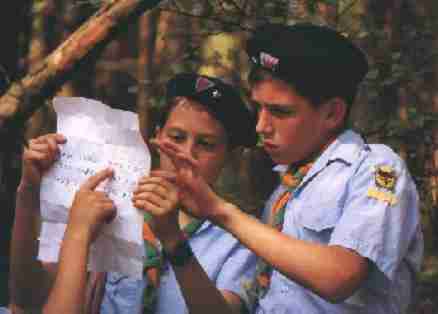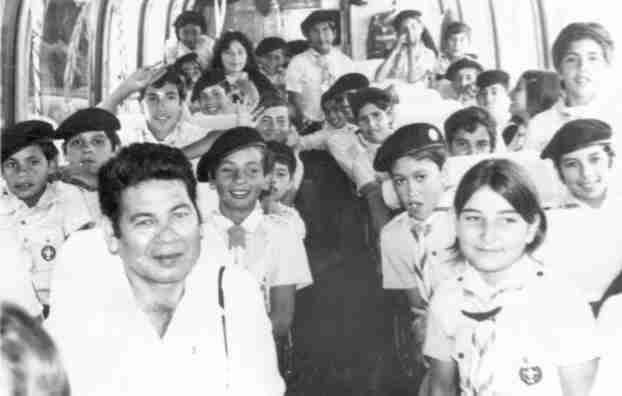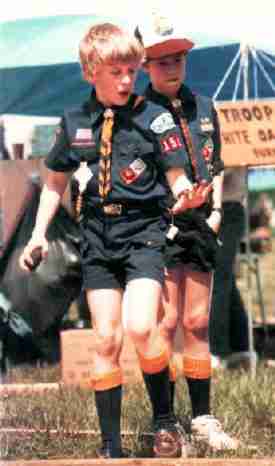
Figure 1.--Scouts around the world wear many different kinds of caps. Berets like those worn by these French Scouts are some of the most common.


Figure 1.--Scouts around the world wear many different kinds of caps. Berets like those worn by these French Scouts are some of the most common. |
The traditional Boy Scout hat was the lemon-squeezer hat designed by Lord Baden Powell. Scouts wore these hats for decades. Gradually different caps were introduced in various countries. Many other types of headgear, mostly caps are now worn by Scouts and Cubs, many reflective the destinctive headgear of the specific country. The peaked English Cub cap was also widely worn for years by Cubs around the world.
The issue of headgear can get quite complicated. One English Scouter, for example, stresses his belirf that the uniform wor by troops should be complete--that means that all the members wear whatever the troop standard is. he reports that in the United Kingdom that in thec1990s Scouts do not wear hats apart from Sea Scouts and Air Scouts. His old Air Scout troop used to wear full uniform (including berets) for inspection. Then kids went to the cloakroom and changed. They wore shorts and sweatshirts under their uniforms for games etc. and changed for the closing. Hats were worn on " public " occasions except (a)
for church parades etc.; (b) on airfields (for safety reasons) or (c) when the person in charge decided otherwise. He can see no excuse for kids wearing non-uniform headgear with uniform
apart from religious regious. Sikh Scouts here wear a turban,
preferably in green or blue to match the Cub/Scout or Sea/Air Scout uniforms respectively, although he doesn't advise pressing
the point too hard. When conducting a Scouts Own service he usually open with "Would you please remove your hats unless it is your custom to pray with your head covered. Let us pray ... " or whatever. HeI would expect Scouts of any faith entering a
place of worship to conform with "local rules" regarding dress, i.e. in a synagogue they should wear headgear. He does not
object to a Jewish Scout visiting a Christian Church remaining covered, since no disrespect was intended--but again, common sense and courtesy is the key. Likewise I would expect female Scouts to conform to dress code when visiting a mosque, say.
It is courtesy to remove hats when eating in camp, on entering a home etc. and kids need to learn these things so as to avoid giving unintentional offence. But somebody needs to explain these standards. I don't see any problem in requiring basic good manners. He tries to teach these things to Cub Scouts so they become routine. Once these good manners have been internalised they are not do likely to be a problem later. Eventually you will get a Troop or Pack tradition. His old troop used to dress for
Sunday dinner in uniform and do something a bit special. In the end the Scouts themselves will set the standards.
Another Scouter reports that in Canada, during our WoodBadge Training, we teach our Leaders the traditions on hats (reference any church guard policies). I have a friend who went with a troop to the World Jamboree in Korea, as they entered the dining area, the Canadian Contingent Leader began insisting that my friend and his son Remove their hats for the meal. Evidently, the Contingent Leader didn't know that Jewish folk have been
eating with their hats ON for thousands of years. (Yes, he knew they were Jewish.) It's really not all that hard to try to accomodate a variety of views and traditions, and most people, I believe, feel good that they've been considered, even if it doesn't work out perfectly.
The first Scout hat designed by Baden Powell was the traditional lemon-squeezer hat wore by generations of Scouts.
Despite its long-term popularity, it had some problems as Scout
headwear. (American Scouts in the 1950s began calling it Smokey Bear hats.) It was hard to be kept smart looking once it got wet, a bad feature for a uniform intended for outdoor uses as in Scouting. It was also expensive.

Figure 2.--These Chilean Scouts in 1976, like many Scouts around the world, wore berets as their offical headgear in the 1970s. |
Some French Scouts began wearing berets in the 1910s, but most Scouts continued to wear the traditional hat. Berets were generally seen as a French style. It was not until after World War II that Scouts in several other countries began wearing them. They were adopted by the English Scouts in 1969. Undoubtedly the bere worn by General Montgomery during World War II helped popularize berets in England.
American Scouts began wearing campaign caps after Worl War II.
They were the most popular American scout cap during the 1940s-70s. This cap was adopted by the U.S. Army in the 1940s and immediately picked up on by the Scouts. It proved much more popular than the old "lemmon-squeezer" style which was in many ways inpractical. I know of few other countries which also adopted this style. The Scouts that I am aware of that picked up this style were Asian countries like the Philippines and Korea where American styles were very influential.
American Scouts in the 1950s wore a fatigue-style cap, but it never proved very popular.
American Scouts in the 1950s wore a red wool cap with ear flaps for winter activities.
American Scouts adopted baseball caps in 1980. This was the first official use of the baseball cap in Scouting. Previously individual units had had group baseball caps prepared. Several foreign Scouts have since followed suit, including Denmark and other countries.
Many Scouts around the world adopted distinctive national headgear such as turbans, fezes, bush hats, and others.
The original English Cubs wore peaked and most countries copied this style. The original cap was green with yellow trim. This style and often the color was used by many different Cubs around the world. Some countries changed the color American Cubs wore blue caps with yellow trim. Some French Cubs also wore blue caps. Japanese Cubs after World War II adopted blue caps.
Berets were mostly worn by Scouts. Most Cubs around the world wore the English-style peaked caps. A few Scout groups, I think mostly French Cubs, also wore berets.

Figure 3.--American Cubs began wearing baseball caps in 1980. Cubs wore caps with yellow fronts. Weblows or Cubs beginning the transition to Scouts wear caps with light blue fronts. |
American Cubs shifted to baseball caps in 1980. They have proven to be much more popular with the boys than the old peaked caps.
Cubs and Scouts as well as adult Scouters have some strong opinions about headgear.
One American Scouter in 1994 reported a heated debate in his troop. He had not seen such a strong debate in my Troop in years. All the members from adults to 10 year olds were heavily ingrossed in debate.
Scouts view: 1. We wear hats in our homes, friends homes, etc. 2. We wear hats in the Mall and stores. 3. It is our Scout Lodge, we should be free to make the rules. 4. Since we have not adopted a uniform hat in this Troop, it should be no different then wearing non-scout pants. 5. We are Scouts not military. 6. To take off your hat only because someone is yelling at you does not show any respect anyway. 7. We see no relation between a hat and respect.
Adult Views: 1. Importance of good uniforming. 2. Taking off your hat in a building is only good manners. (One boy asked
who wrote that rule!). 3. Agree on a Troop hat, if you don't like the Scout uniform hat.
Our troop policy regarding uniforming is an official shirt, neckerchief and dark pants if official pants not available. Hats are optional. However, unless its an official Scout hat it comes off during opening and closing ceremonies. We do have one meeting a month where complete uniforms are required for
inspection. Since we meet in a church hall (new location this year) I asked our pastor the policy regarding hats. He said hats are OK with him. Kids being
kids and since I only have them a few hours a week (I know, they are Scouts all the time) lets get real. I think its more important to try and get something into the head UNDER the hat than risk loosing the boy because of it. As they grow and take on a more responsible role in troop uniforms and hats become less of an issue.
ALthough it nearly impossible with my troops I "suggest"
Scout shirt for the campout with blue jeans/shorts or Scout Pants and I require the uniform shirt for flag raising/lowering/church
services/meals (if in mess situation). I also "suggest" a Scout related
hat for uniform wear and don't care at other times. Scouts wearing
non-uniform hast with uniforms must take them off indoors and in church
etc....
It gets even stricter sometimes. I am an ASM for the Mackinaw
Island Scout Service Camp. Uniform wear is required at any time you are
doing flags/bugling/marching/downtown/or anything related to duty and at
meals. ONLY the official Scout hat may be worn while in uniform and
ONLY the official shorts may be worn unless it rains. And even the
official hat comes off during prayer and dinner. I think if myself and
my fellow leaders (8-10 total) can keep 54 Scouts observing these rules
for 8 days straight that some more relaxed rules can be kept at a campout or meeting without a problem. If a Scout can't stop wearing his Bulls hat for 1.5 hours then he's got a problem....
As for the religious issue: I do not have this problem in eithr
of my troops but if I did then I think a scout hat would be perfectly fine or a yamaka.
I have a Troop of 50 some boys. We are a high adventure (means just a lot of rock climbing, skiing and the like) and are more informal than not. But we do require scouts to wear uniform shirts to all meetings. My problem is that atleast half the boys wear hats (not scout hats). I don't care either way as long as they take them off for flag ceremony and prayer. But I have an assistant leader who is always yelling at them to take off their
hats in the building. This is not something kids typically do when they go to the Shopping mall, stores, etc. Any opinions. Does it really matter? Should I turn it over to a vote by the kids?
It is an old-fashioned matter of good manners to not wear a hat in certain kinds of buildings, especially homes and churches. I'm not sure what the rule is, but I would advise that if your troop meets in a church building, that it
is not appropriate to wear a hat or cap inside, even if they're not in the chapel, sanctuary, etc. Probably most schools, in days gone by, would have expected boys to remove their headwear.
Wearing a hat in a shopping mall, bus station, market, store, or other large public building does not seem to be ill-mannered, and never was, even when not wearing a hat outdoors was unthinkable.
If "A Scout is Courteous" means something, then removing hats when appropriate should be encouraged. On the other hand, I sincerely believe in picking my battles, and I would probably
prioritize this one a little low compared with things like clean language. Most of all, I would really encourage a different motivational style than yelling. Reasoning with the boys, one-on-one (in view of others) :-), is a lot more effective
than yelling. Explain that, in the Church building, reverence AND courtesy require that they not wear caps and hats, and that as part of Scout spirit, you expect them to act appropriately in this regard. Then, instead of yelling, you can remind them
of what they have already agreed to, nay, sworn to. Let their own leaders do the reminding. ("and to obey the Scout Law...", "A Scout is Courteous," "A Scout is Reverent").
As a parent of a 15 year old that INSISTS that he has a HAT to
match his wardrobes. . . . We have encountered some HAT related
probems. Some kids LIKE hats and may spend a months allowance
for some hats. We have had problems when HATS were lots at
CUB and scout meetings. Since our troop does not REQUIRE
a scout hat to have a complete uniform, I personally do not
see a problem to allow scouts or cubs to wear the hat of choice.
However, at a recent camp, we saw a troop wear each patroll
wore a common hat. Troop looked very sharp, but that is getting
off the issue. You also have to be careful about HAT rules
with foreign socuts or certain religions. I say leave the
Decision on the HAT to the indiviual scouts. There are FAR
more important concerns. In fact, I have know cases wear a scout stopped going to meetings when he got hassled about wearing his hat! Lets concentrate on FUN programs!
U.S. Scout regulations require that official headgear may be worn while the unit or individual is participating
in an indoor formal ceremony or service duty, except in religious institutions
where custom forbids. Typical indoor activities of this type are flag
ceremonies, inspections, orderly duty, or ushering service. In any informal
indoor activity where no official ceremony is involved, the headgear is reemoved as when in street clothes. The Scouter dress uniform is always worn without headgear. Pins may be worn on the jamboree hat but only while at the jamboree and Webelos activity badges may be worn on the Webelos cap. No other pins may be worn on official headgear of the BSA.
I, basically, have lost this battle, especially with my own teenage sons. They wear a baseball cap style hat AT ALL TIMES. They have succommed to my unilateral rule of "you are NOT wearing a hat at the table [to eat]!" At all other times, they wear one. Oh well. Pick the battles, I guess. In a previous troop, I did not allow any "non-uniform" items into the hall.
If they wore a hat in the hall, it had to be BSA. This applied to leaders,
too. I.E., if in uniform, wear the uniform. If not in uniform, wear what
you like. Since it was uniform, the hat stayed on unless there was a prayer being said. We had no one of Jewish faith, & if we did, they would have been allowed to keep the hat on. My current troop has (extremely) loose uniforming rules. I would like to do something about that. Summer camp was somewhat different. I was still able to enforce the "total
uniform" rule if they were in class "A"'s. And hats were removed when entering the dining hall. With anything else (class "B"'s), they were allowed anything else. But I did encourage the wearing of a hat all of the time, for sun & tick problems.
I, too, wear a hat which I bought on a trip to Australia. It comes off according to [most] of the "old" rules of etiquette. And, yes, I do wear it with my BSA uniform. Even when I was with the other troop, BUT since it was not BSA, it came off when I came through the door.
I grew up in a Troop and Summer Camp where all hats were removed inside, and non-scout hats were discouraged (although summer camp hats were considered Scout hats). I have carried this attitude with me ever since (I was somewhat uncomfortable a year or so ago when we had a "Hat Day" at work since wanted to take my hat off once I came inside. For an outdoor flag ceremony, a uniform hat is O.K. However, I have been unable to convince anyone else that this should be the case, and have somewhat given up trying. For two years I insisted that my Scouts remove their hat upon entering the dining hall at camp, only to have them point out that everyone else had theirs on --
including the program staff. Now the only time I can get hats off of the
heads of some of my Scouts is when we go to church.
Navigate the Historic Boys' Uniform Web Site:
[Return to the Main Scout garment page]
[Introduction]
[Chronologies]
[Garments]
[Organizations]
[FAQs]
[Bibliographies]
[Contributions]
[Boys' Uniform Home]
Navigate the Historic Boys' Uniform Web chronological pages:
[1900s]
[1910s]
[1920s]
[1930s]
[1940s]
[1950s]
[1960s]
[1970s]
[1980s]
[1990s]
[2000s]
